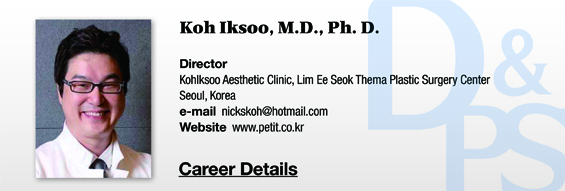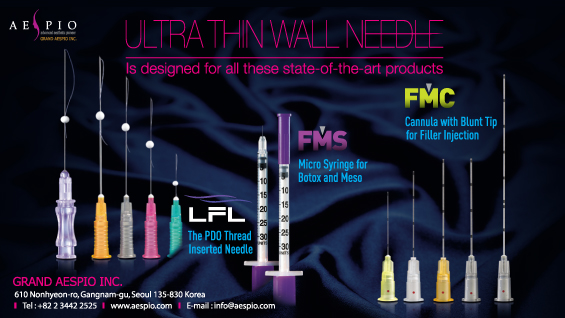Product trends
Korea products such as YVOIRE (LG Life Sciences), Elravie (Huons), and CUTEGEL (BNCKorea), etc. have entered the market and most hospitals and private practices are increasingly choosing domestic products.
However, the most widely used filler is still Restylane (Galderma Korea) which often serves as a reference. For example, when talking about physical properties, it helps understanding when you explain that a certain material has Restylane filler grade. Restylane has grown to be a market leader in the field of fillers.
As more Korean products are entering the market, concerns are also growing. Korean fillers had good quality control in the early days, but as time passes, cases of tissue response related side effects are increasing. Long-term follow-up is difficult with filler procedures and to make matters worse, little is known about the harmful effects of ingredients on surrounding tissues while they remain in the human body for over a year. Studies on toxicity have to be conducted but they have been lacking for domestic fillers.
I am currently investigating filler procedures and their side effects. A German filler product was withdrawn from the market as soon as abnormal tissue responses were found. The increase in side effect cases with Korean fillers is bringing negative impact to the entire market.
[Advertisement] ULTRA THIN WALL NEEDLE – Manufacturer: AESPIO(www.aespio.com)
Marketing
When fillers were first introduced, doctors were the main target of marketing. However, today’s filler marketing takes the B2C (Business to Consumer) form. Filler products are directly marketed to the end consumers through TV, radio and magazines, etc. Some advertisements used celebrity models and the filler products earned the nicknames of ‘Eugenne filler’ or ‘Jiwon Eom filler’, etc. It has become ultimately up to the patient to choose the type of filler they want to have the procedure done in.
On the other hand, TV commercials or celebrity marketing are currently on decline. This is because these types of marketing are costly but the price of filler products are decreasing. In the early days, the treatment price was KRW 1,500,000 for a 1cc filler product purchased at KRW 300,000. Now the treatment price has dropped to less than KRW 500,000. This is also affecting manufacturers of filler products. For example, some manufacturers market Korean fillers for only KRW 30,000 to 40,000, whereas some even provide filler products as a gift. As filler procedures are becoming more affordable, manufacturers are struggling to break even. Therefore, costly B2C marketing is out of question for these companies.
Market outlook
These days, the low prices of fillers and botulinum toxin are used to lure in patients for more expensive procedures. Moreover, the filler procedures and techniques also seem to be generalized such as cold remedies provided at primary care.
As filler prices are dropping, many procedures are often combined in order to raise the price of the procedure. This may be part of an effort to enhance efficacy by adding other treatments to a filler, however, raising prices should be considered to improve the status of filler procedures. Fillers do not command much respect as the price is too low and anyone can perform or receive it. Moreover, injection of excessive amounts often results in side effects.
Some worry that the quality of filler products suffer as manufacturers are lowering the production cost. Doubts remain as to the integrity of ingredients, simplified processing, and use of additives for meeting global standards. To resolve such issues, I believe manufacturers should be more strictly regulated to prevent overcrowding of the market.
In the next issue, I would like to provide honest assessment of filler brands that I have used in my clinical practice. Below are my personal assessment criteria for new fillers.
1. Initial swelling
-Is there severe swelling 1-2 days after injection?
Swelling can be caused by inadequate pH levels or cross-linking agent toxicity, or endotoxin content. Swelling could be a good non-laboratory indicator for the safety of the product.
2. Hydration
-HA fillers can contain water. How much water is good for efficacy?
The post-procedure volume can be determined depending on the water content of the product. Should the doctor stick to the accurate dose? Or, should he inject slightly less considering the swelling from hydration? The duration of hydration is also important.
3. Shape
-How long is the initial shape maintained?
Soft filler products do not maintain the shape well. Hard fillers are easier to handle and have lasting effect but are difficult to shape. The maintenance of the initial shape over long-term is very important.
4. Convenience of use
The convenience of use is determined by injectability and moldability, etc. Understanding of hard and soft filler properties can help adjust the techniques accordingly. Generally, hard fillers offer poor convenience than soft fillers.
5. Longevity
-Longevity is the most important aspect of fillers.
Follow-up for over a year is needed to assess longevity.
6. Safety
-Safety cannot be over emphasized.
Currently, the biggest problem with safety of fillers is the risk of granuloma, a type of tissue response to filler materials. A filler product that seems safe at first but can later cause frequent swelling and hardening, etc. leading to granuloma. Such fillers should not be used.
-To be continued-





















